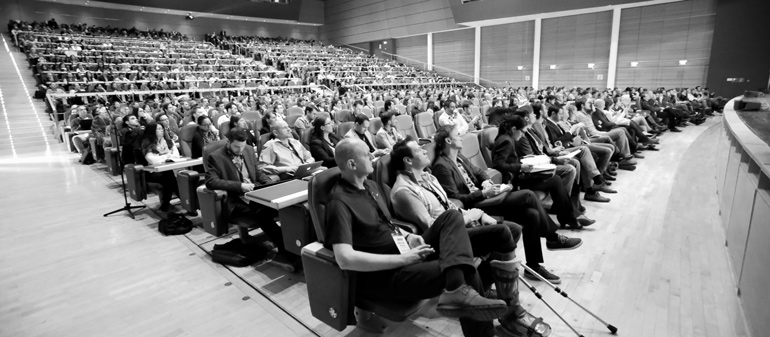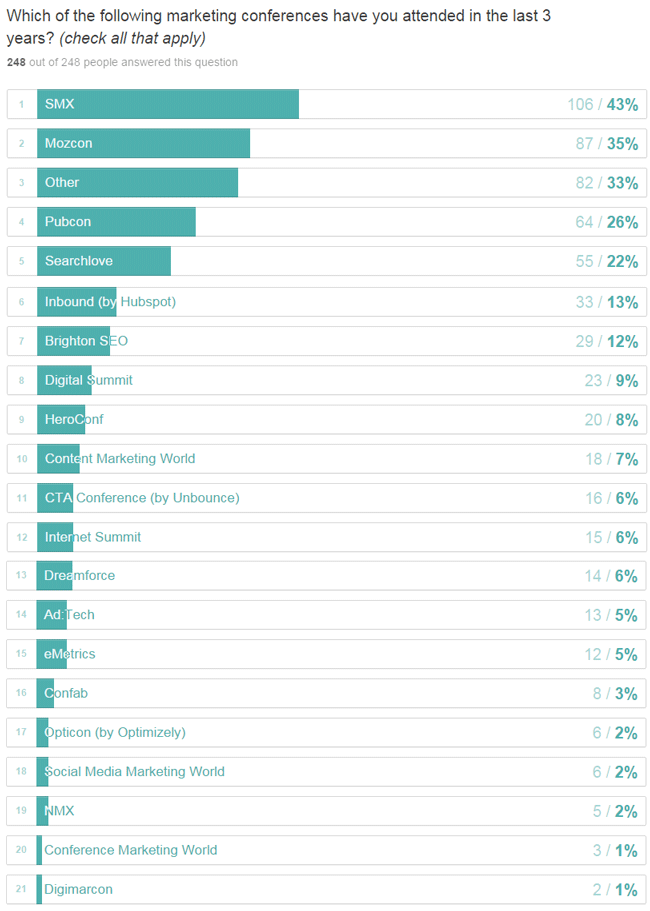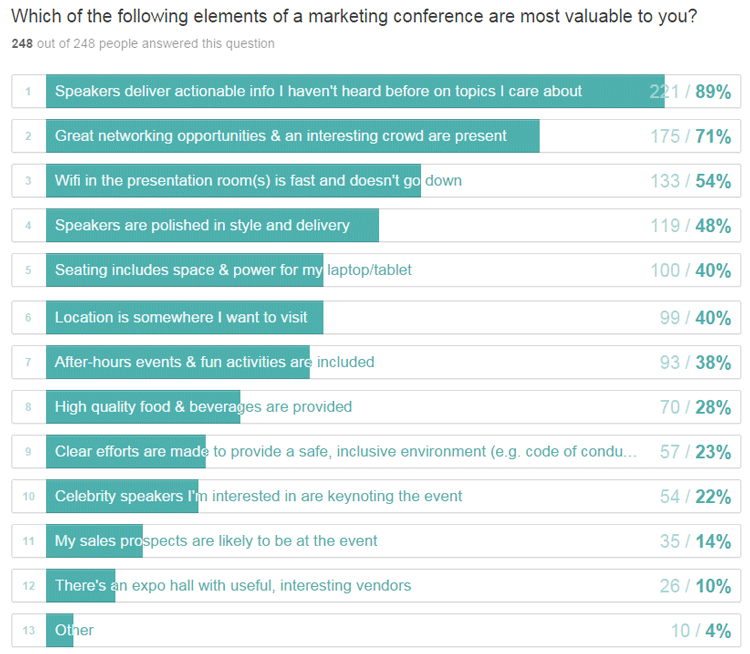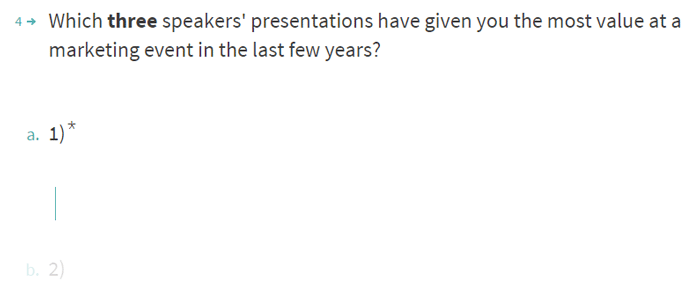Over the course of a few days in mid-December, I ran a survey asking folks about their experiences at conferences and events in the marketing world. 248 people replied, primarily via Twitter, Google+, and LinkedIn. Despite the small number of questions, I found the responses immensely valuable and quite interesting. A few even caught me by surprise.

SMX Munich in 2014 (via Web & Tech)
To start, let’s look at which conferences were most popular/attended in our field:

Not surprisingly, there’s some biases to Mozcon (a conference put on by the company I founded), but the rest are likely relatively representative of what’s popular among SEO-focused marketers. SMX is precisely where I thought they’d be, and their numerous locations and events surely help bolster their reach among this crowd.
Most surprising to me? The relative small number of folks who’d been to Salesforce’s Dreamforce and Hubspot’s Inbound conference. Those events are massive in scope – Dreamforce boasts 30,000+ attendees and Inbound, 10,000+. My expectation would have been that a larger subset of the audience taking this survey would have been at least once to these in the last few years. Based on these responses, I’m guessing two things are true: 1) SEO-focused marketers don’t go to these huge events as much as I thought and 2) my social audience (which comprised the majority of the survey takers) aren’t big attendees of these large events either.
Also interesting was the vast number of folks who entered “Other.” Only a handful of events were mentioned more than once, including:
- Searchfest Portland by SEMpdx
- Dallas State of Search by DFWSEM
- C3 New York by Conductor
- Marketing Festival Brno
Beyond these were another 40 events with only a single mention, many of which I’d never heard of. It would appear the long tail of marketing events is big, and I think this impacts conference organizers’ abilities to draw crowds. The choices of what to go to are overwhelming. Unlike 2004, when Danny Sullivan’s SES conference series was very nearly the only game in town, today there are hundreds if not thousands of events geared toward search and inbound marketers.
Next up, let’s look at how attendees generally feel about the value of events:

This is actually a bit higher than I’d have guessed, and I’m pleasantly surprised to see it. I think my perception was biased by a small number of vocal folks who complain to me that they no longer get value or as much value from conferences as they did in the past. I found that viewpoint frustrating because, as someone who speaks at (and therefore gets to see) 30+ events a year, I have observed that the quality of everything (speakers, presentations, spaces, food, after-hours events, swag, booths, etc) about events in the search/SEO/inbound marketing space have, on average, improved dramatically vs. years past.
Probably the most interesting and important responses, at least for conference organizers, were to the next question, about how attendees derive value from events:

If you want to put on an event that these types of audiences will appreciate, the blueprint seems fairly clear: great speakers on salient topics + a space that enables laptop usage during the talks will get you most of the way there. I find this personally ironic and a little frustrating, as do many conference speakers and event organizers I talk to. As a speaker, seeing lots of folks on laptops, connecting to wifi, and “working” or “multi-tasking” during presentations can be frustrating. It is definitely true, in my experience, that laptop use by the audience during a talk is highly correlated with that audience perceiving the talk to be of low value. At Mozcon, you can almost perfectly predict a speaker’s scores from the back of the room by looking at the percentage of laptops open vs. shut.
That said, as an attendee, I totally get it. You want fast web access and a keyboard at your fingertips not just so you can answer a few emails or see what’s on Twitter if a speaker’s not engaging you, but also so you can tweet about the event, take notes, visit URLs and try out tools mentioned by a presenter, and generally use your device to connect more deeply with a presentation.
Speakers’ importance to an event’s overall value is obvious, but I was actually surprised by the ubiquity of this response compared to the lower resonance of things like the presence of sales prospects and an interesting expo hall. I think I’ve over-attributed attendee’s perceived value to those things based on a few vocal folks who’ve told me they “don’t go to events for the speakers anymore.” These folks are mostly the same as those I cited above as receiving little value from conferences overall, which makes sense. Thanks to this survey, I think I can better appreciate and filter the relative popularity of those opinions in the future 🙂
Finally, I asked about the speakers that stood out in the survey participants’ minds:

Below is a list of the speakers mentioned most:
- Mentioned by 18+ respondents
- Rand Fishkin* (58)
- Wil Reynolds (43)
- Mentioned by 16-17 respondents
- Lexi Mills
- Dr. Pete
- Larry Kim
- Oli Gardner
- Mentioned by 9-15 respondents
- Cindy Krum
- Annie Cushing
- Marshall Simmonds
- Matthew Brown
- Dana DiTomaso
- Eric Enge
- Mike King
- Paddy Moogan
- Mentioned by 5-8 respondents
- Avinash Kaushik
- Joanna Lord
- Nathalie Nahai
- Peep Laja
- Gary Vaynerchuck
- Marty Weintraub
- Phil Nottingham
- Mentioned by 3-4 respondents
- Ann Handley
- Kristina Halvorson
- Kindra Hall
- Lisa Meyers
- Will Critchlow
- Elizabeth Marsten
- Joanna Weibe
This group didn’t surprise me tremendously – a lot of the speakers who tend to have the most visibility and keynotes at the conferences mentioned above made the list. I was very glad to see Cindy Krum and Lexi Mills do so well – IMO, both are keynote-worthy speakers. I also know that both Larry Kim (from Wordstream) and Oli Gardner (of Unbounce) have been working tirelessly to bring up their speaking game and clearly it’s showing through.
One potentially surprising item for those outside our industry might be the lack of any speakers from the major search engines or social platforms. But, while those speakers (especially folks from Google) do have plenty of keynote opportunities and visibility, they would also rank very poorly on my personal list of “provided value in their talks.” I don’t whether company policy, culture, legal, or something else drives that, but it’s been sad to see that, as compared to years past when Google speakers like Matt Cutts and Vanessa Fox would probably have been on this list, the modern cohort is conspicuously absent.
My biggest takeaways from the survey overall are:
- The number of marketing conferences continues to grow unabated, and many of the smaller and regional events are attracting serious crowds. I think it will be harder and harder for series like Pubcon/SMX and company conferences like C3/Mozcon to stand out from the crowd unless we find some remarkable, unique advantages.
- Speakers are still the biggest reason people are going to events. Marketers want to learn, and they want to discover new knowledge. I think that’s why the recent advice I’ve had for speakers here and on Whiteboard Friday resonated.
- Presenters may dislike it, but attendees want to have room for their laptops, power, and wifi. As frustrating as it is for speakers to try and compete against an audience’s emails and social accounts and web browsing, organizers are clearly serving a real need.
- Some of the speakers putting in the most (and most vocal) time and effort to improving their on-stage work are making headway and earning results.
Thanks to all who participated! If you’ve got points to add or feedback, I’d love to hear about it in the comments.
* This shouldn’t be considered a valid result as I was the creator and distributor of the survey, so the participants were, undoubtedly, biased and primed to write-in my name. Wil, however, is clearly winning over crowds like crazy. Bravo, sir.
